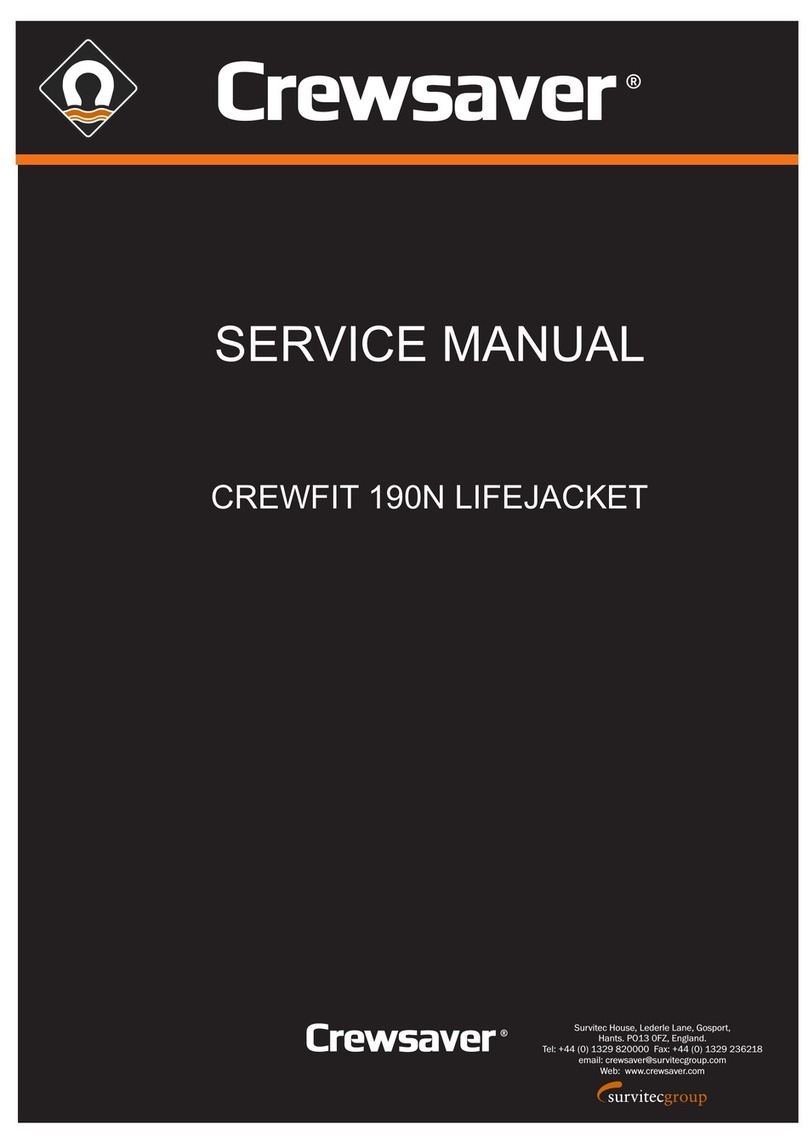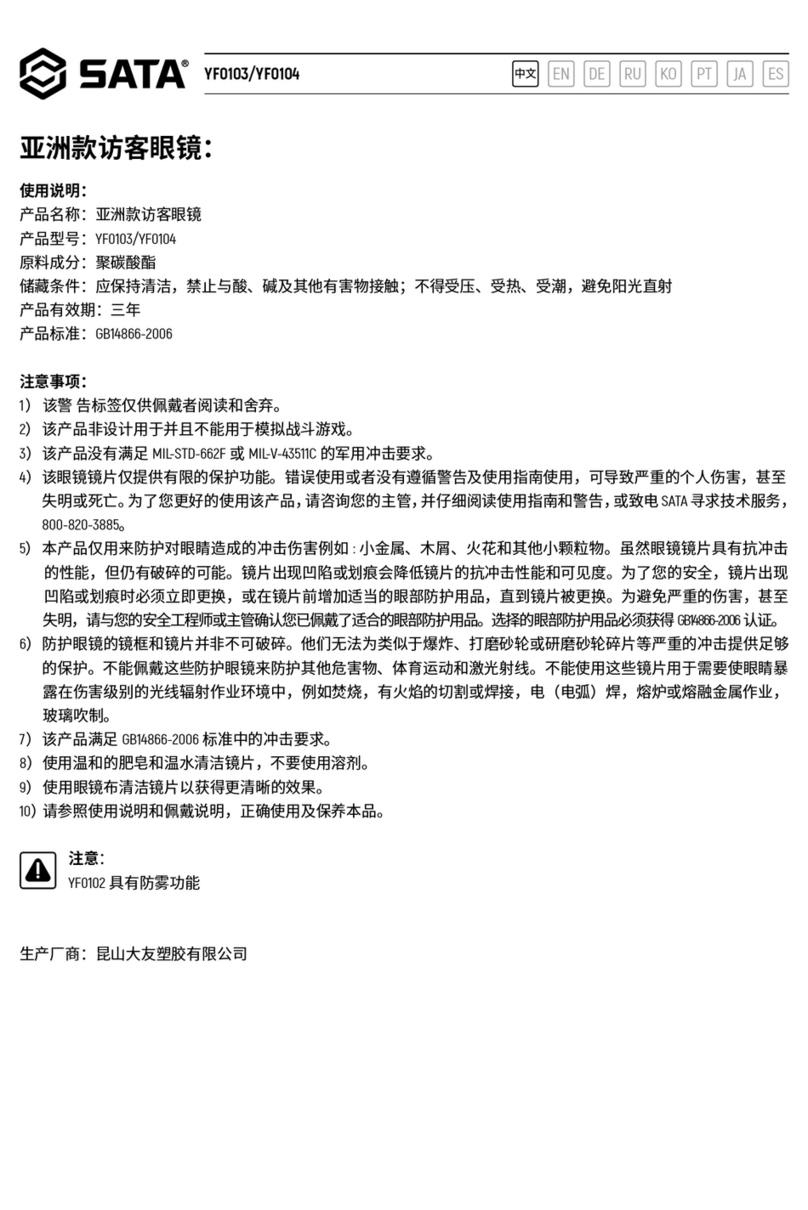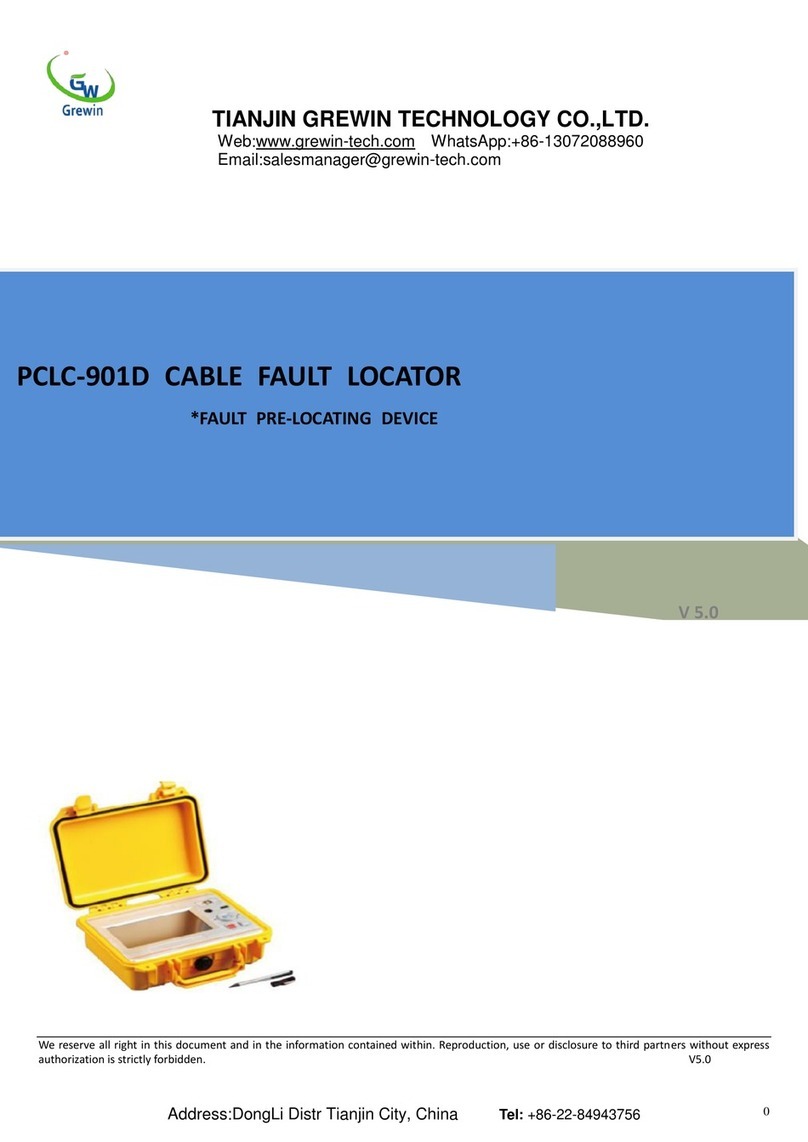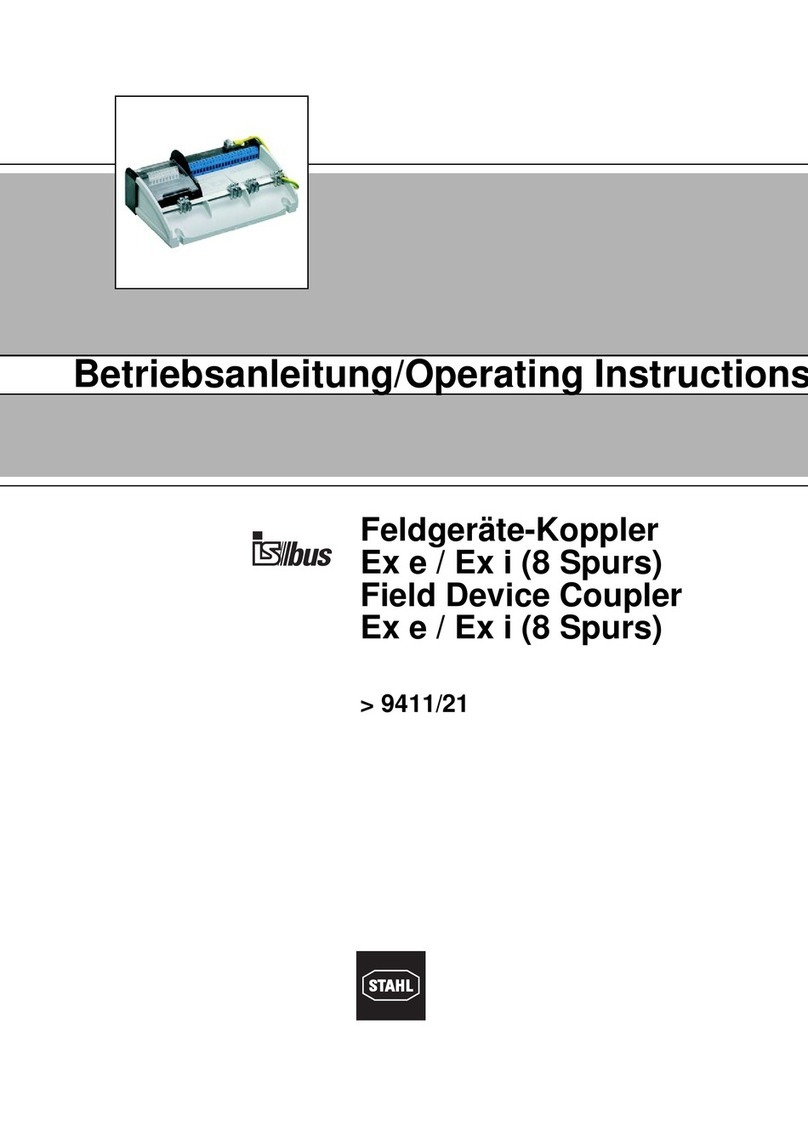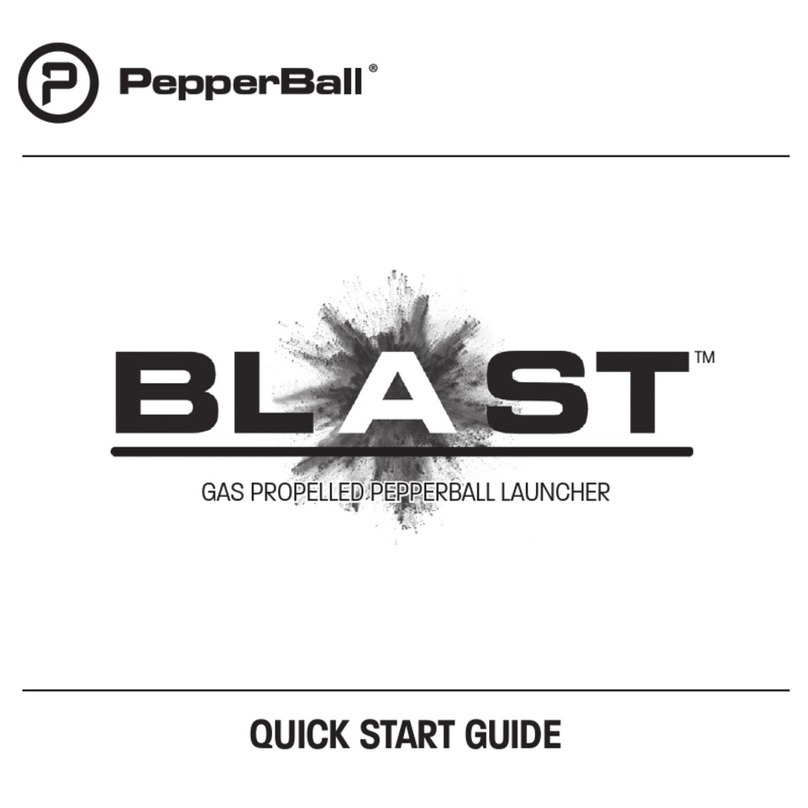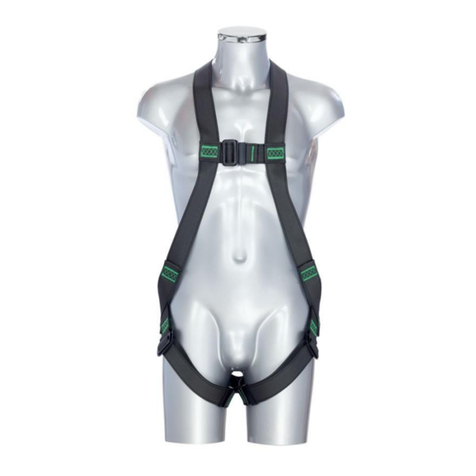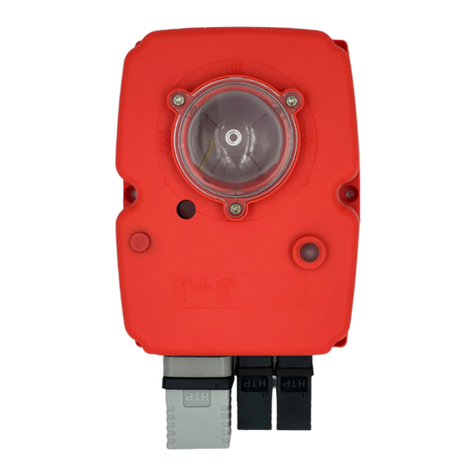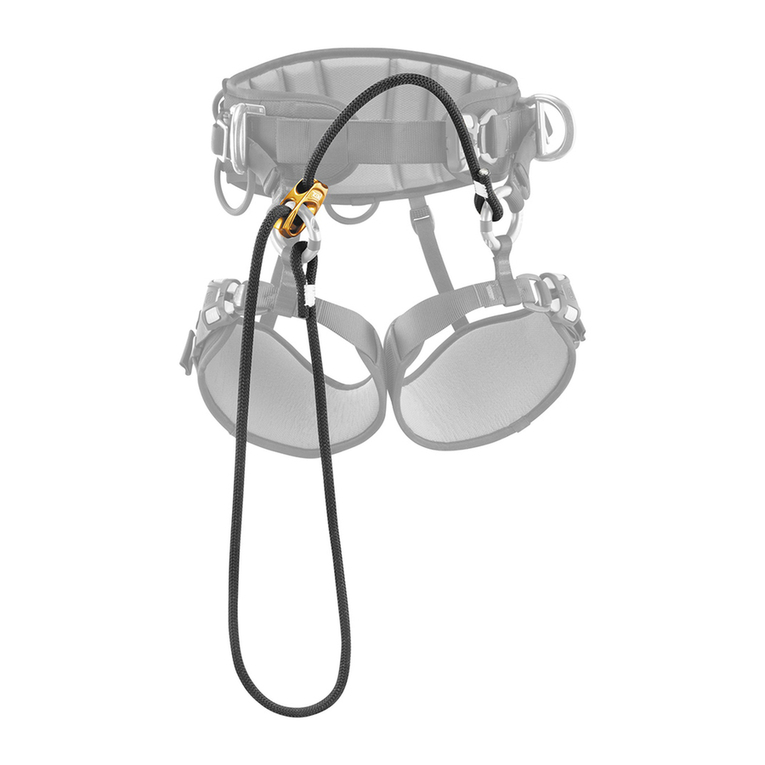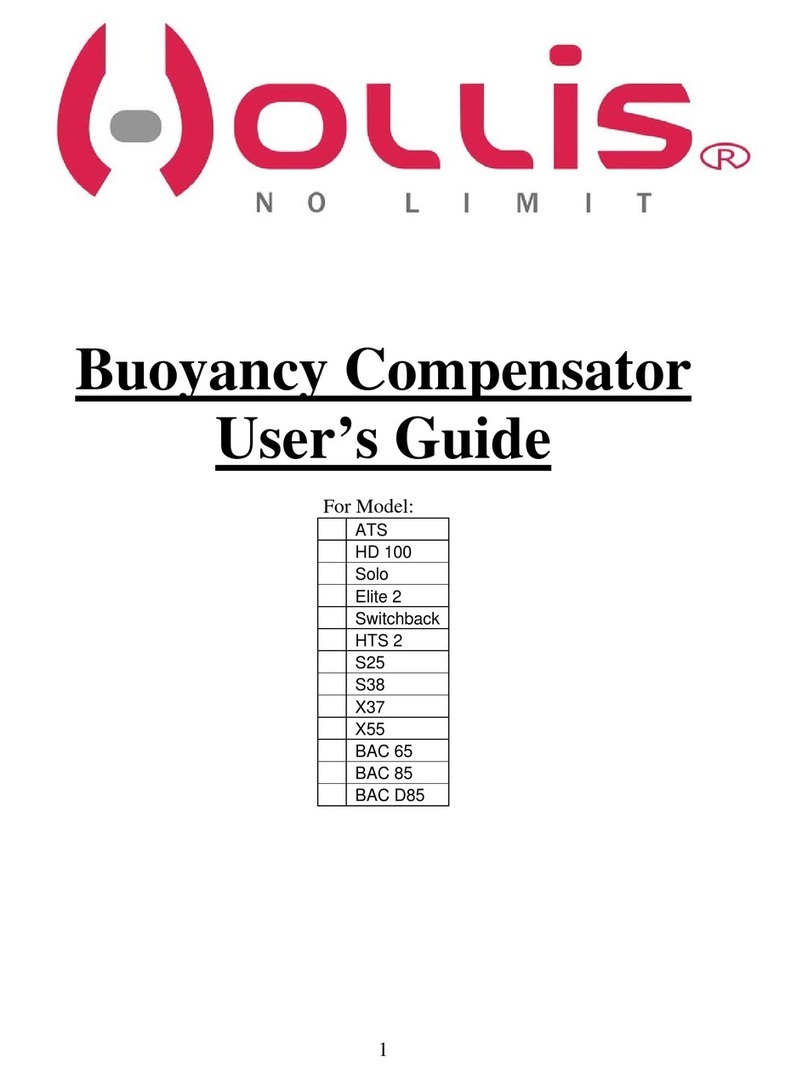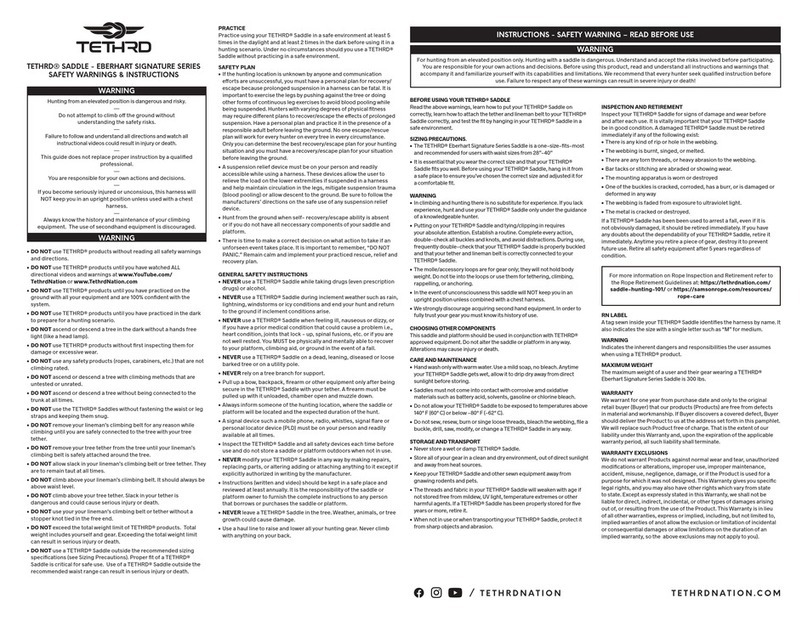Crewsaver CREWFIT 150N User manual

Date: August 2015
Issue No: 1
Crewsaver - Servicing Manual: Crewfit 150N Junior Lifejacket
Page
Of 27
1
SERVICE MANUAL
CREWFIT 150N JUNIOR
LIFEJACKET
Survitec House, Lederle Lane, Gosport,
Hants. PO13 0FZ, England.
Tel: +44 (0) 1329 820000 Fax: +44 (0) 1329 236218
email: crewsa[email protected]
Web: www.crewsaver.com

Date: August 2015
Issue No: 1
Crewsaver - Servicing Manual: Crewfit 150N Junior Lifejacket
Page
Of 27
2
No. Description Date
Service Bulletins and Amendments Register

Date: August 2015
Issue No: 1
Crewsaver - Servicing Manual: Crewfit 150N Junior Lifejacket
Page
Of 27
3
Index
Section 1
1.1 Introduction
1.2 Product Description
1.3 Data Sheet
1.4 General Features
1.5 Donning Instructions
Section 2
2.1 Service Station Guidelines
2.2 On Receipt Inspection
2.3 General Care
2.4 Servicing Tools
2.5 Lifejacket Servicing Record Sheet
Section 3
3.1 Unpacking the Lifejacket
Section 4
4.1 Cleaning Lifejackets
Section 5
5.1 Inspection
Section 6
6.1 Testing
Section 7
7.1 Repairs
Section 8
8.1 Assembly
Section 9
9.1 Replacement Parts
Scope
This manual covers primarily the servicing of the Crewfit 150N Junior Lifejacket.

Date: August 2015
Issue No: 1
Crewsaver - Servicing Manual: Crewfit 150N Junior Lifejacket
Page
Of 27
4
1.1.1. This Service Manual will be published on the Crewsaver website (www.crewsaver.com). Click on PARTNER
/LOGIN at the top of the screen. Personnel who have been trained in the servicing procedures for this
lifejacket will be issued with a Username and Password to enable them to access the download section.
Each manual carries an Issue Number and records of issue are logged by Crewsaver to ensure that the
service network maintains correct and up to date servicing information. Emails will be sent regarding any
new Issues. Periodically service bulletins may be issued which will be published on the Crewsaver website
(www.crewsaver.com). Emails will also be sent. It is the service station's responsibility to regularly check the
website for any new bulletins and to ensure inclusion within the servicing manual. The service bulletin
register at the front of the Manual should be completed.
1.1.2. The information referenced in each section follows a standard servicing procedure by which the inspection
should take place.
1.1.3. This servicing manual details information to enable regular maintenance and servicing of the lifejacket to
help prolong the life of the product and ensure it functions correctly.
1.1.4. The manual should be used as a reference document following training in servicing procedures instructed by
Crewsaver approved personnel. The manual also details the equipment and parts needed for correct
maintenance to be performed.
1.1.5. Servicing must be carried out annually at a service station authorised by the manufacturer .
1.1.6. Regular servicing is to be carried out by qualified personnel trained by Crewsaver and holding a valid
servicing certificate. Certificates are valid for a period of 3 years.
1.1 Introduction
1.2 Product Description
1 yr
1.2.1. The Crewfit 150N Junior is a single chamber 150N inflatable lifejacket.
1.2.2. The lifejacket is ISO approved to 12402-3.
1.2.3. The lifejacket is easy to don.
1.2.4. The buoyancy of the jacket is provided by a single chamber with an oral tube to ensure the full buoyancy can
be achieved upon or after inflation.
1.2.5. This lifejacket is inflated by an automatic firing mechanism.
1.2.6. This lifejacket is fitted with an integral deck safety harness version approved to ISO 12401. This is fitted with
a soft loop in place of the usual stainless steel D-ring.
1.2.7 The outer cover is made from a hard wearing material and is fastened by zip. The colour of the outer cover is
normally red.
1
Section

Date: August 2015
Issue No: 1
Crewsaver - Servicing Manual: Crewfit 150N Junior Lifejacket
Page
Of 27
5
1.3.1 Data Sheet
Features:
Chamber Buoyancy:
Buoyancy Category:
Cover Colour
MCA (UK) Approved
SOLAS Approved
ISO Approved
Cylinder size
Pro-Sensor Automatic
Manual Override
Oral inflation tubes
Pressure relief valves
Hard wearing cover
Whistle - fitted
Retro-reflective tape
Lifting Becket - fitted
Light
Spray Hood
Thigh straps - fitted
Fall Arrest Harness
Closure method
Crewfit 165N Classic Lifejackets
165N
150N
Red
-
-
X
23g
X
X
X
N/A
X
X
X
X
Optional
Optional
-
N/A
Quick Burst Zip
1
Section

Date: August 2015
Issue No: 1
Crewsaver - Servicing Manual: Crewfit 150N Junior Lifejacket
Page
Of 27
6
1
Section
1.4.1 General Features - Crewfit 150N Junior
Product description Front and Back
QBZ Zip
Burst tab
Front cover
Elastic Webbing tidy
Waist belt
webbing
Adjuster buckle
Crotch strap buckle
and retainer webbing
Release tab
YKK
Oral Inflation
Tube
Whistle
Pro-Sensor Auto
firing head
Retro reflective tape
Retro reflective
tape
Light retaining bracket

Date: August 2015
Issue No: 1
Crewsaver - Servicing Manual: Crewfit 150N Junior Lifejacket
Page
Of 27
7
1
Section
1.5.1 Donning Instructions - Crewfit 150N Junior
1
2
3
Don like a normal jacket
Fasten front buckle
Adjust waist belt by pulling webbing backwards for a close secure fit
Fasten crotch strap buckle and adjust straps by pulling webbing downwards for
a close secure fit
1
43 5
2
BUCKLE
THREADING
1 & 2
3
4
5

Date: August 2015
Issue No: 1
Crewsaver - Servicing Manual: Crewfit 150N Junior Lifejacket
Page
Of 27
8
2.1.1 Service stations shall comply with the following as a minimum;
2.1.1.1 Servicing of Inflatable Lifejackets shall be carried out in a fully enclosed area only.
2.1.1.2 The area shall be well lit and protected from direct sunlight.
2.1.1.3 The temperature and humidity shall be sufficiently controlled to ensure that the servicing of inflatable
Lifejackets may be carried out successfully.
2.1.1.4 The area shall be efficiently ventilated but free from draught.
2.1.1.5 Sufficient tools (including specialist tools) shall be available to ensure Lifejackets may be
disassembled, tested and reassembled in accordance with this Manual. These shall include but not
limited to:
2.1.1.5.1 Manometers and pressure gauges.
2.1.1.5.2 Oil free and dry air supply.
2.1.1.5.3 Scales for weighing Gas Cylinders.
2.1.1.5.4 Crewsaver Service tool kit (See 2.6). This is recommended but similar calibrated devices
may also be used.
2.1.1.6 Stock of materials and components to allow efficient servicing with readily available replacement parts
to ensure a prompt service for the customer.
2.1.1.7 Only personnel trained and certified in accordance with Crewsaver requirements are approved to
carry out Servicing and Maintenance. They must be holders of a valid Certificate issued by
Crewsaver.
2.1.1.8 The service station shall be of an approved standard.
2.1.1.9 Procedures shall be introduced to ensure that service bulletins, Manuals and replacement parts are
obtained from Crewsaver.
2.1.1.10 Subsequent to initial approval and thereafter the service station shall be subject to regular surveillance
by Crewsaver.
2.1.1.11 The service station must comply with and have met all QA criteria in the Crewsaver servicing protocol
file.
2.2.1 On receipt of the Lifejacket(s), check the state of the packaging before opening and notify the owner
and the company delivering the package of any defects or damage.
2.2.2 On opening the package, check the contents for their general condition and quantity.
2.2.3 Prepare Servicing Record Sheet.
2.2.4 Visually inspect the cover and inflation chamber for damage, abrasion, contamination etc. In
accordance with this manual.
2.2.5 Note repairs or replacements required on the record sheet.
2.2.6 Unless obvious damage is evident, test the Lifejacket in accordance with Section 6. If it is considered
that the damage found would cause the Lifejacket to fail the tests then corrective action shall be carried
out prior to testing.
2.2.7 Damaged areas shall only be marked using wax based crayon. Marks shall be with a small circle or
cross. Ballpoint, rollerball or other forms of ink shall not be used. If in doubt refer to Crewsaver for
guidance.
2.2.8 Repairs to the outer cover are limited to that detailed in section 7.1.
2.2.9 Repairs to welded components including the inflation chamber are expressly forbidden.
2.1 Service Stations
2.2 On Receipt Inspection
2
Section

Date: August 2015
Issue No: 1
Crewsaver - Servicing Manual: Crewfit 150N Junior Lifejacket
Page
Of 27
9
2.3.1 The Lifejacket should be stowed in accordance with the manufacturer’s instructions.
2.3.1.1 Lifejackets should be stowed in a dry compartment. Avoid high humidity, such as a car boot.
2.3.1.2 Automatic Lifejackets should have stowage facilities which are provided with a method to
encourage moisture removal.
2.3.1.3 Lifejackets should be stowed vertically, for example hung on hooks, in order that any trapped water
or condensation can drain away naturally.
2.3.1.4 Lifejackets should be rinsed in fresh water and dried thoroughly after use.
WARNING
Prior to sponging or washing remove automatic capsules from the firing mechanism. Allow to dry thoroughly
afterwards.
2.3.2 Contaminants such as oil or diesel fuel may be sponged off immediately with clean water and allowed
to dry naturally.
2.3.3 Mud can be removed with a stiff (not wire) brush when dry.
o
2.3.4 The outer cover may be hand washed in good quality mild detergent in cool water (40 C). Rinse well, drip dry
naturally in air.
2.3.5 Sponge the inflation chamber with pure soap solution only. Rinse in clean water immediately, inflate and
allow to dry naturally in air.
WARNING
Do not use proprietary cleaning fluids, thinners, spirits or similar substances.
2.3.6 In cases of severe contamination the unit shall be deemed beyond economic repair and the customer
advised to purchase a replacement lifejacket.
2.3 General Care
2
Section

Date: August 2015
Issue No: 1
Crewsaver - Servicing Manual: Crewfit 150N Junior Lifejacket
Page
Of 27
10
2.4 Lifejacket Servicing Tools
2.5 Lifejacket Service Record Sheet
2.5.1. An electronic copy of the sheet is available to aid reproduction (or copy next page).
2.5.2. Each lifejacket serviced should be recorded either individually or as a batch, showing the serial
numbers and the work performed during the service.
2.5.3. The service record sheet should be signed and a copy given to the owner certifying that the
lifejacket has been serviced.
2.5.4. All replacement parts should be noted - recording either the serial numbers of the component or the
expiry date.
2.5.5 The record sheet shown on the next page is a recommended version. Similar record sheets,
including the same information, may also be used.
2
Section
Fig. 2.4 Table of Tools Required
Crewsaver Servicing Tool Kit
A fine screw driver or tool suitable for removing gaskets
Boning tool
Roller
Brushes
Scissors or good quality trimming shears
“Chinagraph” pencil
Tailors chalk
Fine point indelible pen
1 off metal calibrated metre stick
Scales to weigh gas cylinders 0-1000gram (+1/-1 grams)
Adaptor/tee piece for testing inflation chambers.
Manometer 0-500Mbar
Timing Device
Thermometer 0-40ºC
Clean and dry air supply
1 off ball pein hammer
450mm wide bag sealer (3mm element)
Suitable large surface area for the work to be carried out
1 off FR steel cabinet (adhesive store)
1 off HD industrial sewing machine (e.g. Singer 96K, Juki, Durkopp etc.)
N.B. In case of difficulty contact Crewsaver direct (Not sewing machines, cabinets or tables - these parts may be sourced locally.)
Note: Prior consent to carry out any repairs must be pre-approved by Crewsaver. All repairs to stitching must be in accordance with this
manual.
Description Type

Date: August 2015
Issue No: 1
Crewsaver - Servicing Manual: Crewfit 150N Junior Lifejacket
Page
Of 27
11
2
Section
LIFEJACKET SERVICING SCHEDULE
SERVICED BY:
CERTIFICATE NUMBER:
VESSEL
W/O Number:
Crewsaver
LAST SERVICED BY DATE OF LAST SERVICE
SERIAL NUMBER/S:
CHAMBER INSPECTION COMMENTS
GENERAL CONDITION
MATERIAL
WELDS
WEBBINGS
RETRO TAPE
WHISTLE
ORAL TUBES
RELIEF VALVES
MANIFOLDS
SCHRAEDER VALVES
CYLINDERS
LIGHT
CYALUME POCKET
BUDDY LINE
INFLATION MECHANISM COMMENTS
OPERATING MECHANISM
CORD
AUTOMATIC CAPSULE
WASHERS
RETAINING NUT
RETAINING CLIP
TOGGLE
SPRAY HOOD COMMENTS
FABRIC
ATTACHMENT
VELCRO
REPAIRED ITEMS (COMMENTS)
TYPE
CUSTOMER
WEBBINGS COMMENTS
WAIST BELT / HARNESS
BACK STRAP
LIFTING BECKET
CROTCH STRAP
BUCKLES
STITCHING
ON
OFF
RELIEF VALVE TEST RESULTS FRONT
CHAMBER
OPEN
CLOSE
REAR
CHAMBER
DATE:
COVER COMMENTS
MATERIAL
VELCRO
ZIP
PLB POCKETS
PRESSURE TEST RESULTS
FRONT
CHAMBER
REAR
CHAMBER
TIME
TEMP. ON OFF

Date: August 2015
Issue No: 1
Crewsaver - Servicing Manual: Crewfit 150N Junior Lifejacket
Page
Of 27
12
UML Mk3 Auto Socket
2.6 Lifejacket Servicing Tool Kit
UML Mk5 Auto Socket
Turned Socket
Calibrated Socket Driver
(Tighten Cylinder)
Calibrated Socket Driver
(Remove & Replace Locking Nuts
For UML & HR)
Calibrated Torque Driver
(Schraeder Valve)
2
Section 2

Date: August 2015
Issue No: 1
Crewsaver - Servicing Manual: Crewfit 150N Junior Lifejacket
Page
Of 27
13
3.1 Unpacking
3.1.1 Open the velcro tab. To avoid damaging the lifejacket zip, pull apart the zip, and open the zip via the
quick burst elements, holding the cover on either side.
Once the zip has opened insert the a finger and slide it around the outside of the lifejacket. The
lifejacket cover should now be open and the inflation chamber visible. Both sides of the zip should be
apart with the zip slider free to move back around the lifejacket to the start.
WARNING: All defects should be noted onto the service record sheet.
3.1.2 Remove the operating mechanisms.
3.1.2.1 Following unpacking refer to Fig 3.2 - UML Prosensor Operating Heads
3.1.2.1.1 Unscrew the Automatic Capsule, if fitted, from the operating mechanism. Place to
one side for testing and reassembly later. See Section 6 for details.
3.1.2.1.2 Carefully remove the inflation cylinder by unscrewing it from the operating
mechanism. Retain for further Inspection. Refer to Section 5.
3.1.2.1.3 Remove Operating Mechanisms by removing the screw cover and unscrewing the
retaining nut on the top of the inflation mechanism. Retain for further Inspection.
Refer to Section 5.
3.1.3. Remove light and battery if fitted. Place to one side for further inspection. Refer to section 5.
3.1.4. For Cleaning. Refer to Section 4.
3.1.5. Carry out visual inspection. Refer to section 5.
3
Section

Date: August 2015
Issue No: 1
Crewsaver - Servicing Manual: Crewfit 150N Junior Lifejacket
Page
Of 27
14
3
Section
Fig 3.2 UML Prosensor Operating Heads
4 Remove the operating head from the manifold which is welded to the inflation chamber fabric.
Inspect the bottom sealing O-ring. This must be replaced with a new part if damaged.
3 Remove the protective cover and unscrew the retaining screw from the top of the firing head,
using the torque screwdriver. Check for corrosion and discard if corroded. Inspect the top
sealing O-ring. This must be replaced with a new part if damaged.
2 Unscrew the CO cylinder from the operating head. Once the cylinder has been removed inspect
2
the Cutter O-Ring . Check the O-Ring is in place and that it is in a good condition. Take the
cylinder and check to see if the cylinder has been used. This should be performed by check
weighing. If under the minimum weight as displayed on the cylinder body, discard in a safe
manner.
1 Unscrew the Automatic firing capsule from the end of the operating head. This should only be
done after the test detailed in Section 6 has been performed in order to test the old unit, or if the
operating head has already been fired. Discard and replace with a new automatic firing capsule
upon reassembly. The Capsule must be replaced if it expires before the date of the next annual
service.
5 Check the pull cord and toggle for fraying or damage.
A B D C
E
Cutter O-Ring
CO cylinder
2Retaining
screw
Automatic
capsule
with end
cover
Indicators
Pull cord and
toggle
AUTOMATIC
D C
Retaining
screw cover

Date: August 2015
Issue No: 1
Crewsaver - Servicing Manual: Crewfit 150N Junior Lifejacket
Page
Of 27
15
4.1 Cleaning Lifejackets
4.1.1 The current standard cover of the Crewfit 150N Junior is made from a 300d polyester fabric with a
polyurethane coating that can be cleaned with care.
4.1.2 For all types of cover, mud can be removed with clean water and can be cleaned with a stiff (not wire)
brush when dry.
4.1.2.1 Contaminants such as oil or diesel fuel may be sponged off immediately with clean water and
allowed to dry naturally.
4.1.2.2 Mud can be removed with a stiff (not wire) brush when dry.
4.1.2.3 Covers may be hand washed in good quality mild detergent in cool water (40°C). Rinse well,
air drip dry.
4.1.3 Sponge the inflation chamber with PURE SOAP SOLUTION ONLY. Rinse in clean water immediately,
inflate and air dry.
WARNING: Do not use proprietary cleaning fluids, thinners, spirits or similar substances.
4
Section

Date: August 2015
Issue No: 1
Crewsaver - Servicing Manual: Crewfit 150N Junior Lifejacket
Page
Of 27
16
5.1.1 Visually inspect the cover material for wear, abrasion, pulled threads, contamination, cuts and holes.
5.1.2 If necessary the cover may be washed. Refer to Section 4.
5.2.1 Visually inspect the inflation chamber material for wear, pulled threads, contamination or signs of
mistreatment .
5.2.2 Visually inspect all welds.
5.2.3 Visually inspect all webbings in accordance with Section 5.6
5.2.4 Visually inspect the whistle and its attachment to the lifejacket for mistreatment, defects, and fraying of
the cord and its attachment.
5.2.5 Test Lifejacket in accordance with Section 6.
5.3.1 Visually examine:
5.3.1.1. For Corrosion (All cylinders corroded with red rust or with visible pitting must be replaced).
5.3.1.2. Pierced or damaged piercing disc.
5.3.1.3. That the cylinder has the correct gas charge - 23 grams CO2.
5.3.2 Check Min Weight of Cylinder against that marked on the barrel.
Remedial Action: If any of the above conditions are found to be incorrect the cylinder shall be replaced. See
Section 9.
5.4.1 Visually inspect for damage.
5.4.2 Test in accordance with Section 6.
Remedial Action: These items are not repairable. Refer to Section 9 for replacement part.
5.1 Outer Cover Inspection
5.2 Inflation Chamber Inspection
5
Section
5.3 Gas Cylinders
23 GRAMS CO2 NOMINAL
MIN GR. WT. 106.0 G
ISI/77209 AUSTRIA 02/07
DO NOT HEAT
Fig. 5.3
5.4 Mouth Inflation Valve

Date: August 2015
Issue No: 1
Crewsaver - Servicing Manual: Crewfit 150N Junior Lifejacket
Page
Of 27
17
5.5.1 Visually inspect the Operation of the Automatic Mechanism for:
5.5.1.1 Operation of the Manual override lever. This shall move easily and freely.
5.5.1.2 Operation of the firing pin cam action. Similarly this shall be a smooth action when
the lever is operated.
5.5.1.3 Firing Pin centre discharge hole clear.
5.5.1.4 Activation cord for frays and damage.
5.5.1.5 Moulded body for cracks and damage. Special attention to be given to the areas
around the operating lever/body connection pin.
5.5.1.6 Check the Automatic plunger at the base of the unit when depressed moves the firing pin
and that the plunger and the firing pin return to their original positions when released.
5.5.1.7 Check that the indicator panels show red when the cylinder and automatic capsule are removed
and show green when the cylinder and capsule are replaced.
Remedial Action: In the event that the Operating Mechanism fails any of the above inspection procedures, the
complete unit shall be replaced. No Repairs are allowed. Refer to Section 9 for the part number of the relevant
replacement part.
5.5.2 Visually inspect the Operation of the Automatic Capsule on the automatic Operating Head:
5.5.2.1 Check plug is in place at the base of the capsule.
5.5.2.2 New Capsules are to be fitted where the expiry date is before the next annual service of the
lifejacket. Capsules are marked with the month and year of expiry.
5.5.2.2.1 If the capsule is to be replaced – Re-fit the old capsule and carry out operational
tests. Refer to section 6.
5.6.1 Visually inspect for damage:
5.6.1.1. Fraying
5.6.1.2. Pulled Threads
5.6.1.3. Broken Stitches
Remedial Action: Effect repairs in accordance with the Repair Procedures within the limits defined in Section 7.
5.7.1 Visually inspect all buckles used on the webbings for signs of damage or corrosion.
Remedial Action: No repairs are allowed. In the case of damage being found, return the Lifejacket to Crewsaver.
5.8.1. Check all Markings and Labelling are clear and legible.
Remedial Action: No repairs are allowed. In the case of damage being found, return the Lifejacket to Crewsaver.
5.5 Inflation System
5
Section
5.6 Webbings
5.7 Buckles

Date: August 2015
Issue No: 1
Crewsaver - Servicing Manual: Crewfit 150N Junior Lifejacket
Page
Of 27
18
5
Section
5.9 Lights (if fitted)
5.9.1 The Crewfit 150N Junior can be fitted with the Crewsaver CSL Water Activated Light.
Visually inspect the light for signs of damage to:
5.9.1.1. The switch.
5.9.1.2. the cable.
5.9.1.3. the lens and its mounting or housing.
5.9.2 Check expiry date on battery. The expiry date must exceed the date of the next annual service. If
the light has expired or expires before the next service then it must be replaced. (See Section 9).
5.9.3 Ensure that the switch is in the Auto-on position.
5.9.4 Test the assembly as detailed in Section 6
Expiry date
printed on end
Water activated switch in Auto-on position

Date: August 2015
Issue No: 1
Crewsaver - Servicing Manual: Crewfit 150N Junior Lifejacket
Page
Of 27
19
6.1.1. Air Holding Test.
6.1.1.1 Connect through a suitable Tee piece and adaptor, the oral tube with the oral valve in the open
position, to a graduated water manometer (or a similar digital device for measuring back
pressure).
Note: Hammar inflators must be tested with the Hammar operating head fitted to the inflation chamber.
6.1.1.2 Slowly inflate the lifejacket from a regulated supply until manometer reads 200mbar
Warning: Regulated supply pressure must not exceed 20psi.
6.1.1.3 Close off the air supply and leave for 10 minutes to ensure pressure is stable.
6.1.1.4 Check and record the pressure and temperature reading on the Service Record Sheet.
6.1.1.5 Leave for 30 minutes.
6.1.1.6 Check and record the pressure and temperature reading on the Service Record Sheet.
The maximum difference in the two pressure readings (pressure drop) allowed is 10%. The
temperature differential shall be within plus or minus 3 degrees of the original reading. For each
degree Centigrade rise in temperature subtract 2.5 mbar. For each degree Centigrade drop in
temperature add 2.5 mbar to the readings to obtain the actual pressure variation. Should the
temperature variation be outside 3 degrees either way then the test shall be repeated.
6.1 Inflation Chamber
6
Section
PSI
in/H2O in/Hg mm/H2O mm/Hg kg/cm2bar mbar Pa kPa
1.0 27.71 2.036 703.1 51.75 0.0703 0.0689 68.95 6895 6.895
1.1 30.48 2.240 773.4 56.93 0.0773 0.0758 75.85 7585 7.585
1.2 33.25 2.443 843.7 62.10 0.0844 0.0827 82.74 8274 8.274
1.3 36.02 2.647 914.0 67.28 0.0914 0.0896 89.64 8964 8.964
1.4 38.79 2.850 984.3 72.45 0.0984 0.0965 96.53 9653 9.653
1.5 41.57 3.054 1054.7 77.63 0.1055 0.1034 103.43 10343 10.34
1.6 44.34 3.258 1125.0 82.80 0.1125 0.1102 110.32 11032 11.03
1.7 47.11 3.461 1195.3 87.98 0.1195 0.1171 117.22 11722 11.72
1.8 49.88 3.665 1265.6 93.15 0.1265 0.1240 124.11 12411 12.41
1.9 52.65 3.868 1335.9 98.33 0.1336 0.1309 131.01 13101 13.10
2.0 55.42 4.072 1406.2 103.50 0.1406 0.1378 137.90 13790 13.79
2.1 58.19 4.276 1476.5 108.68 0.1476 0.1447 144.80 14480 14.48
2.2 60.96 4.479 1546.8 113.85 0.1547 0.1516 151.69 15169 15.17
2.3 63.73 4.683 1617.1 119.03 0.1617 0.1585 158.59 15859 15.86
2.4 66.50 4.886 1687.4 124.20 0.1687 0.1654 165.48 16548 16.55
2.5 69.28 5.090 1757.8 129.38 0.1758 0.1723 172.38 17238 17.24
2.6 72.05 5.294 1828.1 134.55 0.1828 0.1791 179.27 17927 17.93
2.7 74.82 5.497 1898.4 139.73 0.1898 0.1860 186.17 18617 18.62
2.8 77.59 5.701 1968.7 144.90 0.1968 0.1929 193.06 19306 19.31
2.9 80.36 5.904 2039.0 150.08 0.2039 0.1998 199.96 19996 20.00
3.0 83.13 6.108 2109.3 155.25 0.2109 0.2067 206.85 20685 20.69
3.1 85.90 6.312 2179.6 160.43 0.2179 0.2136 213.75 21375 21.37
3.2 88.67 6.515 2249.9 165.60 0.2250 0.2205 220.64 22064 22.06
3.3 91.44 6.719 2320.2 170.78 0.2320 0.2274 227.54 22754 22.75
3.4 94.21 6.922 2390.5 175.95 0.2390 0.2343 234.43 23443 23.44
3.5 96.99 7.126 2460.9 181.13 0.2461 0.2412 241.33 24133 24.13
3.6 99.76 7.330 2531.2 186.30 0.2531 0.2480 248.22 24822 24.82
3.7 102.53 7.533 2601.5 191.48 0.2601 0.2549 255.12 25512 25.51
3.8 105.30 7.737 2671.8 196.65 0.2671 0.2618 262.01 26201 26.20
3.9 108.07 7.940 2742.1 201.83 0.2742 0.2687 268.91 26891 26.89
4.0 110.84 8.144 2812.4 207.00 0.2812 0.2756 275.80 27580 27.58
4.1 113.61 8.348 2882.7 212.18 0.2882 0.2825 282.70 28270 28.27
4.2 116.38 8.551 2953.0 217.35 0.2953 0.2894 289.59 28959 28.96
4.3 119.15 8.755 3023.3 222.53 0.3023 0.2963 296.49 29649 29.65
4.4 121.92 8.958 3093.6 227.70 0.3093 0.3032 303.38 30338 30.34
4.5 124.70 9.162 3164.0 232.88 0.3164 0.3101 310.28 31028 31.03
4.6 127.47 9.366 3234.3 238.05 0.3234 0.3169 317.17 31717 31.72
4.7 130.24 9.569 3304.6 243.23 0.3304 0.3238 324.07 32407 32.41
4.8 133.01 9.773 3374.9 248.40 0.3374 0.3307 330.96 33096 33.10
4.9 135.78 9.976 3445.2 253.58 0.3445 0.3376 337.86 33786 33.79
5.0 138.55 10.180 3515.5 258.75 0.3515 0.3445 344.75 34475 34.48
5.1 141.32 10.384 3585.8 263.93 0.3585 0.3514 351.65 35165 35.16
5.2 144.09 10.587 3656.1 269.10 0.3656 0.3583 358.54 35854 35.85
5.3 146.86 10.791 3726.4 274.28 0.3726 0.3652 365.44 36544 36.54
5.4 149.63 10.994 3796.7 279.45 0.3796 0.3721 372.33 37233 37.23
5.5 152.41 11.198 3867.1 284.63 0.3867 0.3790 379.23 37923 37.92
5.6 155.18 11.402 3937.4 289.80 0.3937 0.3858 386.12 38612 38.61
5.7 157.95 11.605 4007.7 294.98 0.4007 0.3927 393.02 39302 39.30
5.8 160.72 11.809 4078.0 300.15 0.4077 0.3996 399.91 39991 39.99
5.9 163.49 12.012 4148.3 305.33 0.4148 0.4065 406.81 40681 40.68
6.0 166.26 12.216 4218.6 310.50 0.4218 0.4134 413.70 41370 41.37

Date: August 2015
Issue No: 1
Crewsaver - Servicing Manual: Crewfit 150N Junior Lifejacket
Page
Of 27
20
6.3 Inflation Mechanisms
6
Section
6.2 Valves
6.1.1.7. If Lifejacket fails the Air holding test inspect as follows.
6.1.1.7.1 With the lifejacket inflated carefully brush or spray the surface with a weak solution of soap
and water or alternatively lower the lifejacket into a tank of water to observe for bubbles.
6.1.1.7.2 Identify and mark the source of leakage. Wash off in clean water and allow to dry naturally
in air.
6.1.1.7.2.1 Special Attention to be given to:
a) Manifold Schraeder Core
b) Oral Tube/ Top-up Valve
6.1.2 If the test is satisfactory deflate the Lifejacket in preparation for re-assembly. Refer to Section 8.
6.1.2.1. Insert the inverted oral valve dust cap into the top of the oral valve and expel the air. Do not use
vacuum pumps to deflate lifejackets.
6.2.1. Oral Valve.
6.2.1.1. When removing the test adapter from each oral valve check that the oral valve reseats. If in
doubt this may be checked by placing the valve underwater.
6.2.2 Schraeder Valve.
6.2.2.1 Should a leak be found in the Schraeder valve the faulty core must be removed and a new
valve inserted using the Torque Screwdriver from the tool kit.
6.3.1 Operational Test for Manual Operation.
6.3.1.1 Remove the operating mechanism from the lifejacket. With the cylinder also removed, pull the
lever on the side of the operating head, and check that the firing pin is visibly moving inside
the open end.
6.3.1.2 If the lever does not move, or the firing pin is not clearly moving, the operating head must be
replaced. Refer to Section 9 for part number.
6.3.2 Operational Test for Automatic Operating Heads (to be performed when capsules have expired).
6.3.2.1 Remove the operating mechanism from the lifejacket and remove the cylinder.
6.3.2.2 Assemble the expired capsule onto the body of the operating mechanism.
6.3.2.3 Place the complete unit into water and check that the unit operates within 5 seconds.
6.3.2.4 If the mechanism fails to pass repeat test replace the complete unit. Refer to Section 9 for part
Number of the replacement part.
NOTE: all failures of this test must be reported to Crewsaver. Crewsaver may require the
failed units to be returned. Please do not discard.
6.4.1 If the retro reflective tape shows any signs of degradation the following tests shall be carried out in
accordance with Marine Guidance Note MGN 105 (M+F) Issued by the UK Marine and Coast guard
Agency March 1999.
6.4.1.1 Place a new piece of the same retro-reflective material to, and on the same plane as, a
representative piece of material fitted to the appliance.
6.4.1.2 Pour water over both pieces of material.
6.4.1.3 Using a powerful torch or "Aldis" lamp held at eye level, compare the performance of the two
pieces
of material from a distance of 10 Metres.
6.4.1.4 If a noticeable deterioration in performance is observed then the retro-reflective material on the
appliance should be replaced.
6.4.1.5 Dry off the lifejacket before repacking.
6.5.1. Testing Procedure for lights fitted to lifejackets.
6.5.1.1 Crewsaver CSL Water Activated Light.
Test the light by immersing the sensor in water. The light must flash. Remove the light from the water and dry
it. The light must stop flashing. If the light does not flash the unit has expired and must be replaced.
6.4 Retro Reflective Tape
6.1 Inflation Chamber cont.
6.5 Lights and Batteries
Other manuals for CREWFIT 150N
1
Table of contents
Other Crewsaver Safety Equipment manuals
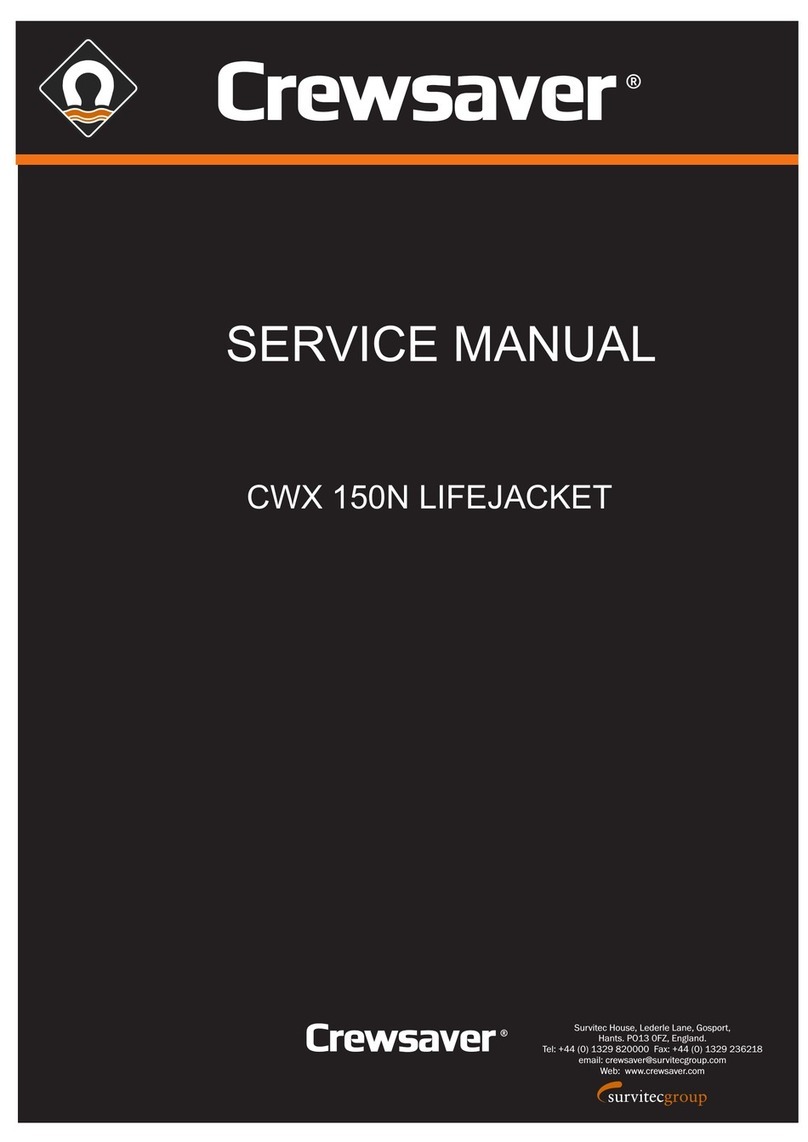
Crewsaver
Crewsaver CWX 150N User manual

Crewsaver
Crewsaver VOYAGER 275N User manual

Crewsaver
Crewsaver ERGOFIT 190 User manual
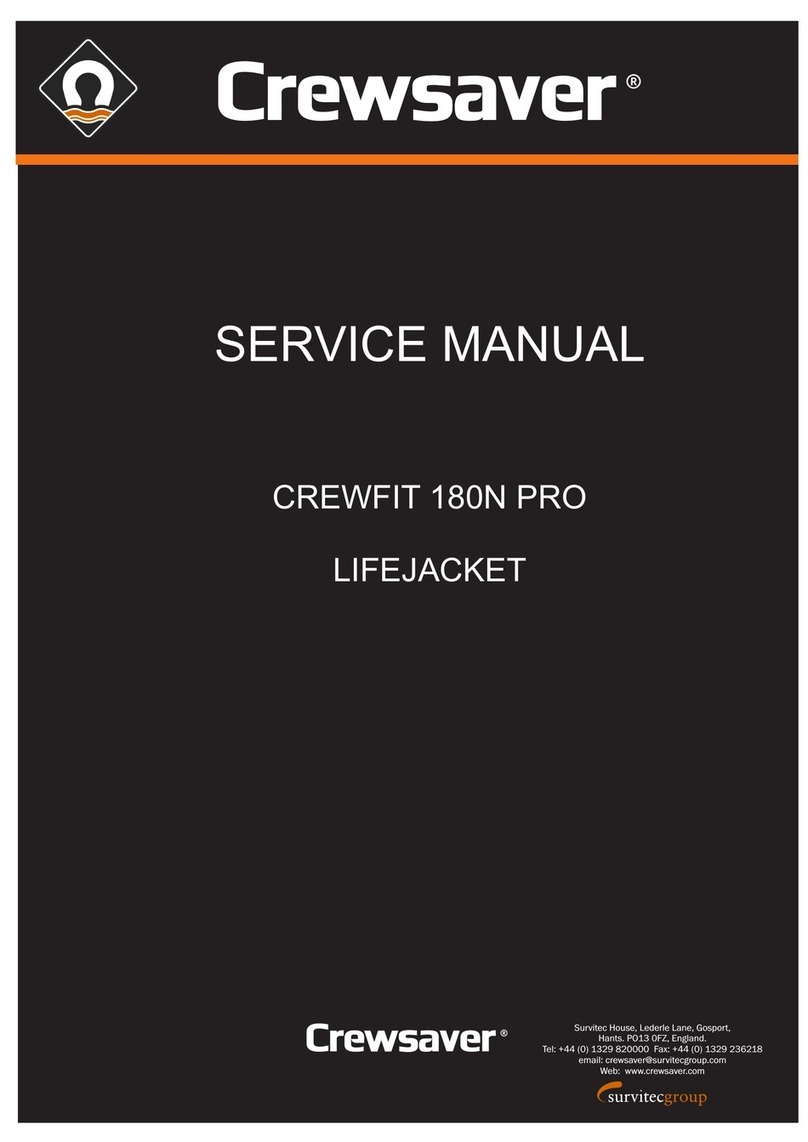
Crewsaver
Crewsaver CREWFIT 180N PRO User manual
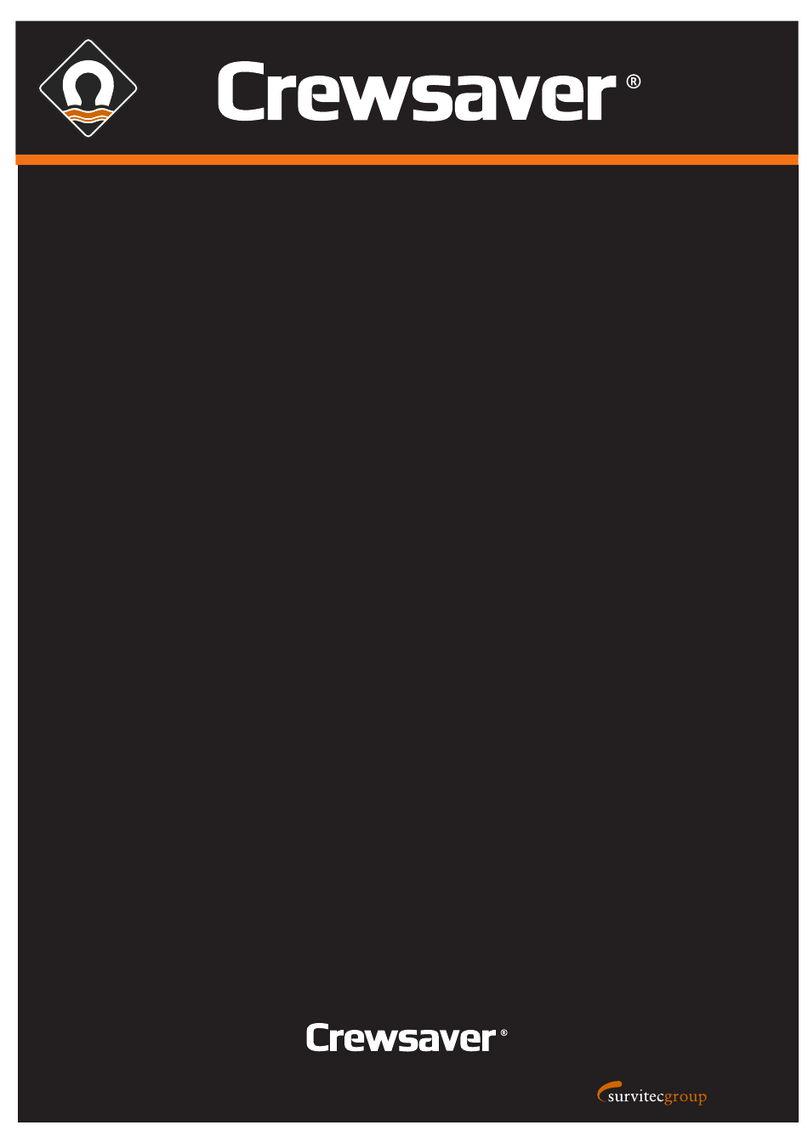
Crewsaver
Crewsaver MIRG ELITE TWIN CHAMBER LIFEJACKET User manual

Crewsaver
Crewsaver CREWFIT 150JUNIOR User manual
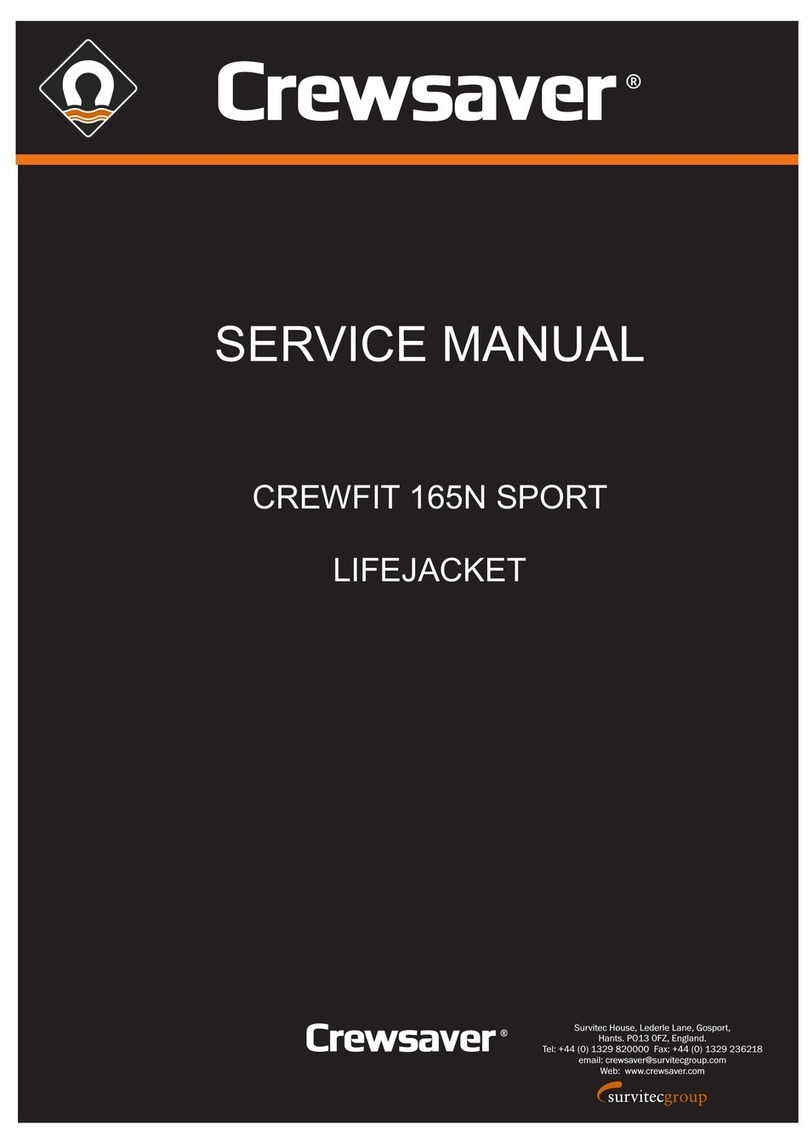
Crewsaver
Crewsaver CREWFIT 165N SPORT LIFEJACKET User manual

Crewsaver
Crewsaver CREWFIT 165 SPORT User manual
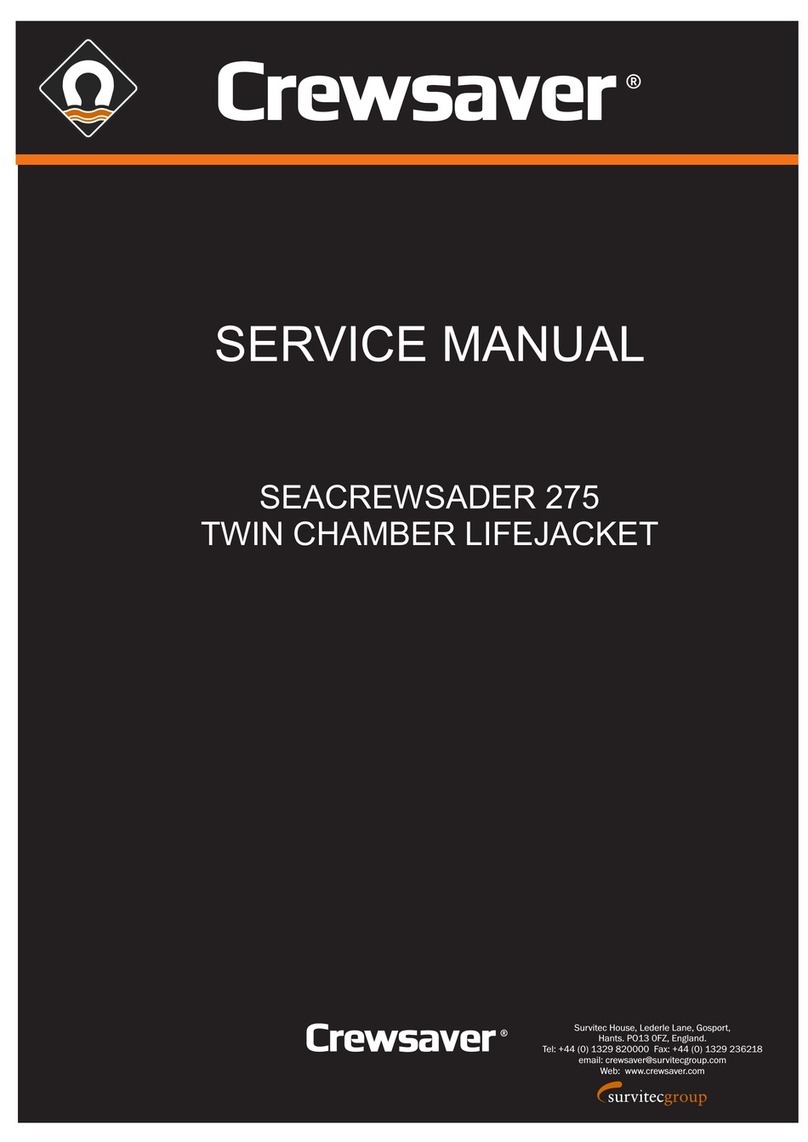
Crewsaver
Crewsaver SEACREWSADER 275 User manual

Crewsaver
Crewsaver CREWFIT 150N User manual
